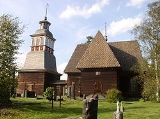
Petäjävesi Old Church
Encyclopedia
The Petäjävesi Old Church is a wooden church located in Petäjävesi
, Finland
. It was inscribed in 1994 on the UNESCO
World Heritage List. It was built between 1763 and 1765. The clock tower that has been built in 1821 is connected to it. UNESCO considered it to be a representative Lutheran church
of the Scandinavia
n tradition, mixing Renaissance
with older Gothic
architectural elements.
The church is about 1 km to the west of the centre of Petäjävesi. The church stayed from the use during the year 1879 when in 1867 the new church of the congregation which has become independent was completed to the present centre densely populated area of Petäjävesi. The old church has retained its original appearance and its interior decoration exceptionally well. It is a popular church for weddings in the summer, and there is a church service on most Sundays.
Petäjävesi
Petäjävesi is a municipality of Finland.It is located in the province of Western Finland, next to Jyväskylä and is part of the Central Finland region. The municipality has a population of and covers an area of of which is water...
, Finland
Finland
Finland , officially the Republic of Finland, is a Nordic country situated in the Fennoscandian region of Northern Europe. It is bordered by Sweden in the west, Norway in the north and Russia in the east, while Estonia lies to its south across the Gulf of Finland.Around 5.4 million people reside...
. It was inscribed in 1994 on the UNESCO
UNESCO
The United Nations Educational, Scientific and Cultural Organization is a specialized agency of the United Nations...
World Heritage List. It was built between 1763 and 1765. The clock tower that has been built in 1821 is connected to it. UNESCO considered it to be a representative Lutheran church
Lutheranism
Lutheranism is a major branch of Western Christianity that identifies with the theology of Martin Luther, a German reformer. Luther's efforts to reform the theology and practice of the church launched the Protestant Reformation...
of the Scandinavia
Scandinavia
Scandinavia is a cultural, historical and ethno-linguistic region in northern Europe that includes the three kingdoms of Denmark, Norway and Sweden, characterized by their common ethno-cultural heritage and language. Modern Norway and Sweden proper are situated on the Scandinavian Peninsula,...
n tradition, mixing Renaissance
Renaissance architecture
Renaissance architecture is the architecture of the period between the early 15th and early 17th centuries in different regions of Europe, demonstrating a conscious revival and development of certain elements of ancient Greek and Roman thought and material culture. Stylistically, Renaissance...
with older Gothic
Gothic architecture
Gothic architecture is a style of architecture that flourished during the high and late medieval period. It evolved from Romanesque architecture and was succeeded by Renaissance architecture....
architectural elements.
The church is about 1 km to the west of the centre of Petäjävesi. The church stayed from the use during the year 1879 when in 1867 the new church of the congregation which has become independent was completed to the present centre densely populated area of Petäjävesi. The old church has retained its original appearance and its interior decoration exceptionally well. It is a popular church for weddings in the summer, and there is a church service on most Sundays.

